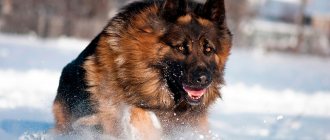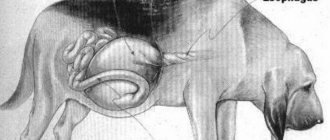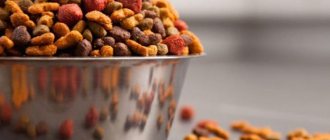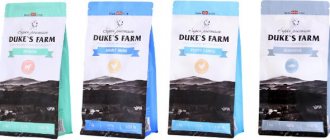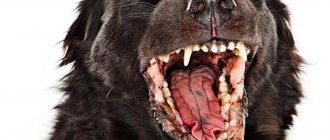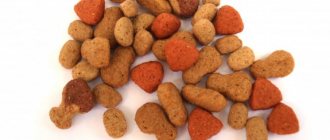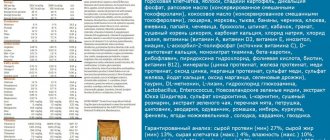Now let's tell an interesting story. About how one villager’s dog ran away from the yard. During heat. Everyone can imagine how it ended. The bitch got pregnant, but the uncle had no idea. I fed her as usual.
At the right time, the dog gave birth. Dead puppies. The uncle was not particularly upset. He buried the puppies, and the dog continued to live in the kennel. Receiving a bowl of strange food twice a day.
There is no need to take an example from the village uncle. If the dog is bred, then it should be fed accordingly. There is no point in abusing animals. What to feed a pregnant dog? Now we'll tell you.
Natural food or feed?
An age-old question that dog owners cannot solve. What to feed your pet? Natural food seems to be healthier. But the food is cheaper.
This is wrong. Cheap food is bad food. Food for pregnant and lactating dogs must be balanced in composition. What is the composition of economy class feed? There's no meat there. Only ground bones, proudly called “bone meal”. Dyes and flavor enhancers. That's the whole lineup. Will such food bring much benefit to the expectant mother and her puppies? Hardly.
Natural food makes the dog “loose”. If you overfeed an animal, there is a risk of difficult birth. Especially for those bitches who are whelping for the first time.
Let's talk in more detail about the advantages and disadvantages of both natural food and dry food.
Diet and regime of a pregnant dog from day 30
- Dogs kept on an unnatural diet are switched to food for pregnant and lactating dogs. The amount of food eaten must strictly correspond to the norm, and the pet must have constant access to water. Overfeeding with dry food, which swells in the stomach, can lead to a number of problems - constipation, gastric arrest, and volvulus.
- Be sure to include dairy products, vegetables, and optional fruits in your diet and strictly monitor your dog’s weight. Gaining a thin layer of fat before childbirth is normal; obesity is a guarantee of complications.
- Spitz dogs, Caucasian Shepherds, Yorkies, all breeds with problem joints or “mixed” blood should receive calcium, phosphorus and vitamin D. Be very careful in dosages and follow the instructions - an excess of calcium and other elements is no less dangerous than their deficiency.
- From day 30, or preferably earlier, start adding 1 drop of vitamin E to your food, sold in regular pharmacies.
- The dog is walked at a calm pace, 30–40 minutes after eating. Nevertheless, strong dogs of “established breeds”, for example, German shepherds, need to be given exercise, optimally walking, until signs of fatigue appear.
- Around the 40th day, the puppies grow up and begin to physically squeeze the internal organs, including the stomach. The dog is transferred to fractional meals - 1/2 serving 4-5 times a day.
- At 53–55 days of pregnancy, supplements, meat and calcium are removed from the diet; this will make the “path” of the first puppy easier.
- Don’t delay walking your pregnant dog; constant “containment of needs” is a spasm that harms both mother and puppies.
Dry food
What to feed a pregnant dog? If the choice fell on food, you should know something about it.
There are several types of dry food. Economy, Premium, Super Premium and Holistic.
As mentioned above, economy food is of poor quality. Manufacturers often write on the packaging: the minimum amount of meat is 4%. These percentages include bone meal. The rest of the composition is cereals, various extracts, carrots and alfalfa. What is hidden under the word “cereals”? This is corn flour or gluten, as a rule. Is it of much use?
Economy class food is not suitable for feeding dogs. Not to mention pregnant and lactating bitches. There is no benefit to these foods.
Premium food. The advantages of such feeds are as follows:
- Contains meat. Although there is not much of it.
- Content of vitamins and minerals.
- Large selection of products. The cost is not very high, but not the lowest either. A 15-kilogram bag will cost an average of 4000-4500 rubles.
Premium line feeds also have disadvantages:
- The percentage of meat is not specified.
- There is a lot of corn flour, just like in economy class food.
- Contains antioxidant E-310. It can become an allergen for the dog.
Among premium foods, we can highlight Royal Canin for pregnant and lactating dogs. It is also suitable for very small puppies. Many breeders feed it to pregnant and lactating pets.
If the owner decides to transfer his pet to Royal Canin, then he should carefully monitor her. If your dog's ears are red, it often itches, his eyes begin to water, and red “pimples” appear on his skin - this is a sure sign of an allergy.
Super premium class. These foods differ in their composition. They contain at least 45% natural meat. Additional ingredients - fruits, vegetables, healthy grains. The main advantage of this food is its composition.
The disadvantages include the high price. A 12-kilogram bag of feed will cost about 5 thousand rubles.
Holistics. This is the best food. Consist of 70% meat. The rest of the composition is rice, vegetables, fruits.
Advantages of the line - holistic:
- Feed composition.
- Product quality.
The disadvantage is the price category. 15 kilograms of this food cost 6-7 thousand.
How much protein should dry food for pregnant and lactating dogs contain?
According to the recommendations of AAFCO, NRC and FEDIAF (North American and European organizations that provide recommendations for food industry standards), the protein level in the guaranteed analysis of food for pregnant dogs and puppies up to 14 weeks of age should be a minimum of 25% (on a dry matter basis), and for puppies that have reached 14 weeks - at least 20%. We recommend checking the guaranteed analysis of the dry food you use in your nursery.
At the same time, it is important that the food is dominated by protein of animal rather than plant origin, since the latter simply lacks a number of substances that dogs’ bodies require. In particular, essential amino acids that cannot be obtained from cereals and vegetables include tryptophan, arginine, methionine, lysine and taurine. And those amino acids that are still present in plant materials may not be in the quantities that dogs need.
Take, for example, corn - a fairly common ingredient in prepared feed. The total protein content in it does not exceed 9–10%, and only half of this share is made up of essential amino acids. Thus, in order to provide the required amount of amino acids, you need to take more protein from the same corn than meat or fish protein. But even in this case, there will be a noticeable lack of certain substances, which will be compensated for by artificial additives.
The biological value of proteins varies
To evaluate protein sources based on the richness of the amino acids they contain, the concept of biological value is used, that is, the more amino acids, the higher the value. If you find individual added amino acids in the food composition list, this means that the raw materials do not contain them in sufficient quantities for the dog.
| Eggs (whole) | 100 |
| Eggs (whites) | 88 |
| Chicken/Turkey | 79 |
| Fish | 70 |
| Lean beef | 69 |
| Brown rice | 59 |
| Brown rice | 57 |
| White rice | 56 |
| Peas | 55 |
| Wheat | 49 |
| Soybeans | 47 |
| Whole grain wheat | 44 |
| Corn | 36 |
| Ripe beans | 34 |
With a lack of proteins, there is a delay in the growth and development of babies, and the absorption of food nutrients worsens; The body's resistance to diseases decreases, muscle tissue is depleted, and the development of reproductive organs is disrupted, which is especially important for breeding puppies.
Effect of temperature on amino acid chains
Methods for processing meat components are very important, because prolonged exposure to high temperatures changes amino acid compounds and also destroys, for example, methionine and histidine; this must be remembered when preparing food yourself in a nursery.
This is why some breeders do not boil the meat completely, but give it to dogs in semi-boiled form; this treatment preserves the biological activity of nutrients and, by partially denaturing proteins, contributes to their better digestibility, making an exception for chicken meat and chicken offal, which they give in boiled form. .
Most industrial feeds are prepared at high temperatures, but some manufacturers, in particular Champion Petfoods (Acana and Orijen feeds), which have modern technological lines, are able to use raw and fresh meat in the production of feed, exposing it to relatively low temperatures (90 ° C at for 4–5 minutes).
A very important criterion for the quality of feed is its digestibility, that is, its ability to be broken down and absorbed in the body. Let us remind you that animal protein is absorbed by dogs by 90%, and vegetable protein by only 60%, so feeding dogs should be in accordance with their biological species. From all that has been said, we conclude that no matter what you feed your dogs, natural or ready-made food, they need a lot of meat, especially breeding bitches and puppies! If you want to raise full-fledged offspring from your breeding bitch, if you want to raise the breed one more step up, feed the dogs and puppies in the kennel fully. Say goodbye to cereals and grain-based foods! Give dogs plenty of meat in their diet and you will see results!
Natural food
What to feed a pregnant dog? Natural food, as an option. What do owners who decide to feed their pet normal food need to know?
- The diet of a pregnant bitch should contain 70-80% protein products. For example, if previously a dog was given 300 grams of meat per day, now this norm has doubled. The expectant mother should eat at least 500 grams of meat daily.
- Fermented milk products are required. Kefir and cottage cheese, fat content up to 1.5%, give 4 times a week.
- Nobody canceled vegetables. All vegetables are good for dogs, except those that have a high starch content.
- Three times a week, the expectant mother should be given fatty fish (flounder, mackerel, tuna, pollock).
- Buckwheat and rice porridges are good for your pet. They can be given by mixing with meat.
- Give boiled eggs twice a week.
Below is a sample menu for a pregnant bitch. The menu is designed for a week.
Menu
How many times should a pregnant dog be fed? For the first three weeks she is fed as usual. Starting from the third week - three times a day.
| Day of the week | Morning | Day | Evening |
| Monday | Rice porridge, boiled fish without bones | Cottage cheese with kefir | Boiled beef meat |
| Tuesday | Buckwheat porridge with vegetable oil | Boiled chicken without skin and bones | Vegetable stew (except potatoes) |
| Wednesday | Vegetable puree with pollock | Rice porridge with apple and pear | Cottage cheese with vegetable oil and egg |
| Thursday | Beef and vegetable soup, without salt and spices | Friendship porridge with egg | Piece of boiled beef |
| Friday | Mashed cottage cheese with apple | Boiled fish with vegetables | Rice porridge with turkey or chicken |
| Saturday | Boiled rabbit with vegetable oil, carrots and cabbage | Beef, chicken and rabbit azu | Rice porridge with kefir |
| Resurrection | Buckwheat porridge with pear and apple | Boiled turkey or duck | Vegetable stew with vegetable or olive oil |
This is what a sample nutrition plan for a pregnant bitch looks like. It can be adjusted based on the imagination of the owners and their financial capabilities.
Vitamins
What vitamins are necessary for pregnant and lactating dogs, not counting those that the pet receives from the diet? There are special complexes for expectant mothers. But they are allowed to be given only after consultation with a veterinarian.
In general, a pregnant bitch needs calcium. There are special vitamins “Calcium 8:1”. They are even suitable for puppies. And yet, before treating your pet with them, it is better to “get the good stuff” from the veterinarian.
The Farmavit line produces Farmavit Neo vitamins for pregnant and lactating dogs. Reviews about them are very good. Consult your veterinarian and move on.
A little about nutrition
How to properly feed a pregnant dog? It was said above that for the first three weeks she is fed twice a day. The diet does not change. During this period, the bitch becomes less active. She may suffer from toxicosis.
After the third week, the pet’s belly becomes slightly rounded. Now she is fed three times a day. From approximately the third to the sixth week, the food intake doubles.
Starting from the ninth week, reduce protein foods. Three days before the expected birth, meat and fish are not given at all.
Nutrition for a pregnant dog
A dog’s diet during pregnancy affects not only itself, but also its offspring. It will be difficult for an overweight animal to give birth, and a bitch that does not receive important microelements in food can give birth to weak puppies with developmental pathologies. Therefore, it is very important to strike the right balance.
Even before mating, do not forget to weigh the dog and monitor its weight throughout pregnancy. In the first month of pregnancy, the dog's weight changes slightly; the main gain should occur after 42 days. If by the end of pregnancy the animal has gained more than 25-30% of its weight, it is worth contacting a veterinarian to adjust the diet.
How to feed a pregnant dog?
In the first three weeks, the dog’s behavior and energy expenditure practically do not change, so it can be fed as before. Bitches do need calcium during this period, but if you feed the animal high-quality commercial food, no supplements are needed. Some dog owners make the mistake of uncontrollably adding calcium to the diet of a pregnant animal, which leads to impaired fetal development. Remember that all supplements must be approved by your veterinarian.
In the third or fourth week, the dog sometimes becomes lethargic, appetite decreases, and indigestion occurs. If such symptoms last more than a week or become severe, it is necessary to take the animal for examination by a specialist.
In the fourth or fifth week, the fruits begin to grow quickly, so the bitch needs special food. From this period, the volume of a pregnant dog’s stomach decreases, so a product from the Starter line is suitable for her - these diets have a high energy density and satisfy the body’s needs with a small portion of food. They also contain highly digestible proteins, rice, prebiotics and fish oil, which improves digestion. These foods can also be used for puppies immediately after the bitch stops feeding them.
Then the bitch begins to gain weight weekly up to 10% of her original body weight. It is important not to overfeed the animal, because obesity can lead to a caesarean section during childbirth. From now on, the daily ration increases by 10% every week. The portion of food increases by 20% by the sixth week, and by 30% by the seventh-eighth week.
A day or two before the onset of labor, the bitch may have a decreased appetite, and a few hours before giving birth, she may not want to eat at all. This should not bother you if there are no other alarming symptoms - nausea, vomiting, bleeding, bowel and urination disorders, excessively restless behavior and whining.
During lactation, veterinary experts do not recommend restricting a dog’s diet. A lactating bitch spends 4–5 times more energy than before the birth of offspring, and she must make up for these costs in full. Otherwise, the dog may become irritable, keep the puppies away from the nipples, and become stressed.
How many times a day should a pregnant dog be fed?
Feed your dog often, but in small portions. An enlarged uterus can put pressure on the digestive system, and a pregnant animal is often unable to digest the same amount of food at one time.
If your dog is free-ranging and expends a lot of energy, has chronic health conditions, or has special needs, consult with a veterinarian about food intake during pregnancy.
dog reproductive medicine pregnancy
Share
After childbirth
We figured out what to feed a pregnant dog and how. How to feed her after giving birth? Three times a day, nothing has changed. The pet wants to eat all the time, which is not surprising. You can’t overfeed, and you can’t underfeed either. Both cases are dangerous to the dog's health.
From two weeks of age, puppies begin to be fed. The first food is warm milk. Starting from three weeks of age, the complementary foods that are planned as nutrition after weaning should be introduced. If it is natural food, then it is beaten until it becomes a paste-like puree.
How to start feeding? It is better to do this in the absence of the bitch, so that the puppies can eat without problems. A little food is taken on your finger and placed in the puppy’s mouth. The main thing is not to overdo it. The portion should be minimal. The puppy will feel the taste and will begin to try to eat on its own. Other puppies will follow the pioneer.
Pregnancy is stressful
Despite how easy pregnancy is for a dog, it is worth remembering that expecting offspring is a huge stress for the animal’s body. A lot changes: hormonal levels, load on the heart and vascular system; Due to the rapidly increasing volume of the uterus, the location of the internal organs temporarily changes, and the load on the musculoskeletal system increases.
The first rule of feeding a dog during pregnancy is no sudden changes in diet. Changing food, and even more so changing the type of feeding, is also stressful. And you shouldn’t put one on top of the other, putting the health of the dog itself and future offspring at risk. At least in the first third of pregnancy, the diet is left unchanged.
Weaning
At what age are puppies finally weaned from the bitch? At 6-8 weeks, this was the case before. Nowadays weaning is practiced at 4 weeks of age. It is not right. Firstly, the puppy does not fully receive vitamins from its mother’s milk. Secondly, such children may have problems with socialization in the future. Thirdly, such a dog is guaranteed to have weak immunity.
Let's summarize
The purpose of the article is to tell the reader as much as possible about the proper diet of a pregnant bitch. So, the main aspects:
- The dog is fed either food or natural food. There should not be a mixed version.
- If the owners have chosen dry food, then they should pay attention to the super-premium and holistic lines.
- Natural food is less balanced than good dry food. But the menu for those who are for natural nutrition is presented above.
- The dog is fed three times a day, starting after the third week of pregnancy.
- Vitamins are given only after consultation with a veterinarian.
- After the puppies are born, the dog's diet does not change until they are weaned.
- Puppies begin to be fed from two weeks of age.
- Weaned from mother at 6-8 weeks.
When to feed a pregnant dog intensively
The second half of pregnancy, or rather its last third, is characterized by increased fetal growth. By 5–6 weeks of pregnancy, puppies have already formed internal organs and basic body systems. From this moment, the actual active growth of the fruit begins.
If previously most of the nutrients, and especially their excess, were spent on providing the mother’s body and storing fat “in reserve,” then in the last third of pregnancy the mother’s body gives almost everything to the future offspring.
Therefore, it is very important, starting from the 6th week after mating, to gradually increase the dog’s diet so that by the end of pregnancy the bitch receives approximately 25–30% more food than usual.


